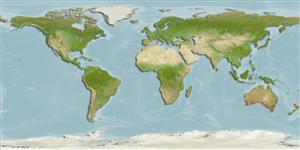Common names from other countries
分類 / Names
俗名 | 同種異名 | Catalog of Fishes(屬, 種) | ITIS | CoL | WoRMS | Cloffa
Teleostei >
Beloniformes (Needle fishes)
頜針魚目 (Needle fishes) >
Hemiramphidae (Halfbeaks)
鱵科 (Halfbeaks)
Etymology: Hyporhamphus: Greek, hypo = under + Greek, rhamphos = beak, bill (Ref. 45335).
More on author: Valenciennes.
Environment: milieu / climate zone / depth range / distribution range
生態學
海洋; 半鹹淡水; 深度上下限 0 - 20 m (Ref. 6390). 溫帶; 27°S - 44°S
Eastern Indian Ocean: Endemic to Australian temperate waters (Murchison River, Kalbarri in Western Australia to Eden, New South Wales, including Tasmania).
東印度洋: 澳洲的溫帶水域的特有種.(Murchison 河, 在澳洲西部到伊甸園,新南威爾斯的卡爾巴瑞, 包括塔斯梅尼亞)
Length at first maturity / 大小 / 重量 / 年齡
Maturity: Lm ?, range 25 - ? cm
Max length : 52.0 cm SL 雄魚/尚未辨別雌雄; (Ref. 10988); 最大體重: 600.00 g (Ref. 6390); 最大年齡: 10 年 (Ref. 27011)
背棘 (總數): 0; 背的軟條 (總數): 15-18; 臀棘 0; 臀鰭軟條: 17 - 20; 脊椎骨: 55 - 61. Gill rakers usually 33 or less on the first arch and usually 26 or less on the second arch. Relatively shorter upper and lower jaw, especially at larger sizes.
鰓耙通常在第一個弓上的 33 以內與通常在第二個弓上的 26 以內。 相當比較短的上頜與下頜, 尤其較大時。
Found inshore in surface waters of estuaries, bays, inlets and gulfs to a depth of about 20 m (Ref. 9563). In the South Australian gulfs, southern sea garfish may be found in deeper waters during the colder months (Ref. 27008). Generally herbivorous, seagrasses and algal filaments comprise about 75% of their food (Refs. 26551, 27013). Form schools, generally found near the surface at night and close to the bottom over seagrass beds during the day (Ref. 6390). Post-larvae or young fish less than 1-year-old live in estuaries from March to July then move to inshore marine waters, remaining there for up to 2 years (Ref. 27012).
在河口,海灣,小水灣與海灣到深度大約 20 公尺的水表面中發現於岸邊了。 (參考文獻 9563) 在南方中澳洲的海灣, 南方的海洋長嘴硬鱗魚在比較寒冷的數個月期間可能被發現於較深的水域.(參考文獻 27008) 通常食草的, 海草與海藻的絲狀突起包含大約 75% 的他們的食物 (參考文獻。 26551,27013). 形成魚群, 通常發現晚上接近水表面處而且接近在海草床上的底部在白天期間.(參考文獻 6390) 生活於河口從三月到七月的後期仔魚或幼魚少於 1 歲然後移動到被逗留在那裡超過 2 年的近海海洋。 (參考文獻 27012)
Life cycle and mating behavior
成熟度 | 繁殖 | 產卵場 | 卵 | 孕卵數 | 仔魚
Viviparous (Ref. 205).東印度洋: 澳洲的溫帶水域的特有種.(Murchison 河, 在澳洲西部到伊甸園,新南威爾斯的卡爾巴瑞, 包括塔斯梅尼亞)
Collette, B.B., 1974. The garfishes (Hemiramphidae) of Australia and New Zealand. Records of the Australian Museum 29(2):11-105. (Ref. 10988)
CITES (Ref. 128078)
Not Evaluated
人類使用
漁業: 商業性; 誘餌: usually
更多資訊
參考文獻養殖養殖資訊品種遺傳學Electrophoreses遺傳率疾病加工Mass conversion
合作者照片Stamps, Coins Misc.聲音神經毒速度泳型鰓區Otoliths腦重體重比眼睛色素
工具
特別的報告
下載 XML
網路資源
Estimates based on models
Preferred temperature (Ref.
115969): 14.3 - 22.3, mean 17.6 (based on 324 cells).
Phylogenetic diversity index (Ref.
82804): PD
50 = 0.5000 [Uniqueness, from 0.5 = low to 2.0 = high].
Bayesian length-weight: a=0.00257 (0.00115 - 0.00574), b=3.09 (2.91 - 3.27), in cm Total Length, based on LWR estimates for this Genus-body shape (Ref.
93245).
營養階層 (Ref.
69278): 2.7 ±0.27 se; based on food items.
回復力 (Ref.
120179): 中等的, 族群倍增時間最少 1.4 - 4.4年 (K=0.51-0.77; tm=2-3; tmax=10).
Fishing Vulnerability (Ref.
59153): Low to moderate vulnerability (28 of 100).
